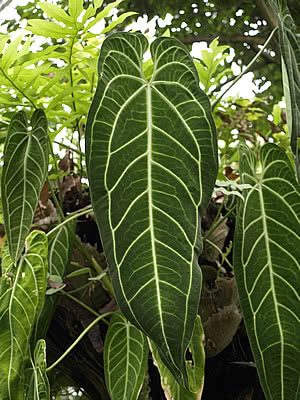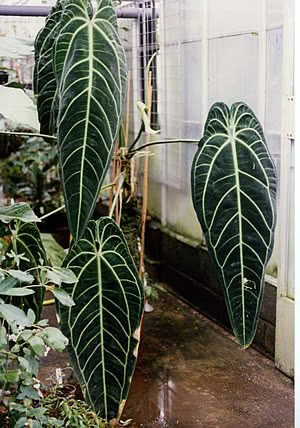The queen anthurium (Anthurium warocqueanum) is an herbaceous and epiphytic plant with ornamental foliage, native to humid equatorial forests in valley and lowland areas, ranging from 656 to 4593 feet in altitude, in Colombia. The species name “warocqueanum” is a tribute to Arthur Warocqué (1835–80), a prominent horticulture promoter in Belgium. Anthurium warocqueanum belongs to the Cardiolonchium section of the genus Anthurium, which includes anthuriums with velvety leaves.
The beauty of this queen of anthuriums lies in the lush appearance of its leaves. Despite showing significant individual variation in shape, color, and veining of its leaves, the queen anthurium is characterized by long heart-shaped leaves that can reach lengths of 11.8 to 23.6 inches. These leaves have a leathery texture and a green color, usually darker than that of other anthuriums, and can even exhibit shades of deep mossy green, nearly black, of exquisite beauty. The silver veining is another striking feature of the species, varying from well-defined and clear to more subtle, depending on the individual.
The inflorescence is of the spadix type, typical of the Araceae family, with a densely packed spike covered in tiny flowers and protected by a pale green-yellow lanceolate spathe (a modified and showy leaf to attract pollinators). The inflorescence can grow up to about 16.1 inches, and when pollinated, it produces berry-like fruits that are red in color. Birds consume these ripe fruits and disperse the seeds by defecating on tree branches.

A stunning plant to cultivate indoors, on balconies, or in protected winter gardens shielded from direct sunlight and wind. The queen anthurium brings a tropical exoticism to the environment while contrasting with the rest of the vegetation due to its darker tones and unique texture. It can also be cultivated in gardens, preferably in a setting resembling its natural habitat, such as on the branches of evergreen trees, where it can find the humidity and fertility it requires to grow. Its growth rate is moderate, and maintenance involves regular fertilization and removal of damaged and old leaves. Despite the species’ individual variation, darker individuals can be obtained by cultivating them in shaded locations, while individuals with lighter foliage thrive in well-lit areas. Keep in mind that the plant prefers good light to grow and won’t flower in dark spots.
It should be cultivated under intense filtered light, protected from direct sunlight, in a substrate suitable for epiphytic plants, such as a mixture of sphagnum moss, charcoal, perlite, gravel, and partially decomposed pine bark. Some prefer to use pure sphagnum moss for cultivating this species. Watering should be frequent, and the substrate should not dry out completely between waterings to prevent dehydration. The queen anthurium also appreciates high relative humidity, around 70%. Therefore, in drier areas, supplementing humidity with a humidifier will be necessary. It does not tolerate intense cold or frost, so in regions with a subtropical or temperate climate, it should be grown in heated interiors or greenhouses. Fertilize monthly with high-quality soluble fertilizer (Peters or PlantProd) in a 10.10.10 ratio, or if preferred, use slow-release organic fertilizers. Propagation is done through cuttings placed in moist substrate to root during spring and summer.


